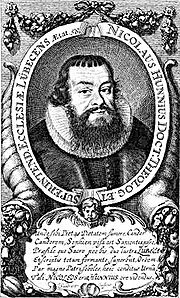
Nicolaus Hunnius
Encyclopedia

son of Egidius Hunnius, was an orthodox Lutheran
Lutheran Orthodoxy
Lutheran orthodoxy was an era in the history of Lutheranism, which began in 1580 from the writing of the Book of Concord and ended at the Age of Enlightenment. Lutheran orthodoxy was paralleled by similar eras in Calvinism and tridentine Roman Catholicism after the...
theologian of the Lutheran scholastic
Lutheran scholasticism
Lutheran scholasticism was a theological method that gradually developed during the era of Lutheran Orthodoxy. Theologians used the neo-Aristotelian form of presentation, already popular in academia, in their writings and lectures...
tradition.
At the age of fifteen he entered the University of Wittenberg, where he studied philology, philosophy, and theology. In 1609 he joined the philosophical faculty and lectured in philosophy and theology. He followed the same theological direction as his father, inherited his temper and talent as a polemist, and was like him, possessed of great learning. In virtue of his
ability Elector John George I. of Saxony
John George I, Elector of Saxony
John George I was Elector of Saxony from 1611 to 1656.-Biography:Born in Dresden, he was the second son of the Elector Christian I and Sophie of Brandenburg....
appointed him, in 1612, superintendent
Superintendent (ecclesiastical)
Superintendent is the head of an administrative division of a Protestant church, largely historical but still in use in Germany.- Superintendents in Sweden :...
of Eilenburg
Eilenburg
Eilenburg is a town in Germany. It lies in the district of Nordsachsen in the Free State of Saxony, approximately 20 km northeast of the city of Leipzig.- Geography :...
, where he won the respect of his superiors and the affection of his congregation. In 1617 Hunnius was called to succeed Leonhard Hutter
Leonhard Hutter
Leonhard Hutter was a German Lutheran theologian.-Life:He was born at Nellingen near Ulm. From 1581 he studied at the universities of Strasbourg, Leipzig, Heidelberg and Jena...
, at Wittenberg, as professor of theology. In 1623 he was appointed pastor of St. Mary's Church at Lübeck
St. Mary's Church, Lübeck
The Lutheran Marienkirche in Lübeck was constructed between 1250 and 1350. For many years it has been a symbol of the power and prosperity of the old Hanseatic city, and as Germany's third largest church it remains the tallest building of the old part of Lübeck. It is larger than Lübeck Cathedral...
; the following year he became superintendent. For the suppression of the enthusiasts who pervaded the region, Hunnius reunited the dioceses of Lübeck, Hamburg, and Lüneburg (Ministrium tripolitanum), and at a convention held in 1633 at Mölln
Molln
Molln is a municipality in the district of Kirchdorf an der Krems in Upper Austria, Austria.-References:...
measures were proposed and adopted for the same purpose. For the suppression of the adherents of Calvinism
Calvinism
Calvinism is a Protestant theological system and an approach to the Christian life...
Hunnius frustrated the efforts of John Durie, who tried to establish harmony between the Lutherans and the Reformed. To check the proselytizing tendencies of the Roman Catholics, he even invoked the aid of the secular powers. At the same time he made earnest efforts to elevate the religious and ecclesiastical life.
Works
It was however, chiefly his polemical literary activity that made Hunnius known among his contemporaries. He wrote against the Roman Church Ministerii Lutherani divini adeoque legitimi demonstratio (Wittenberg, 1614) and Capistrum Hunnio paratum, etc. (1617); against the Socinians, whom he considered as PhotiniansPhotinus
Photinus was a Christian heresiarch and bishop of Sirmium in Pannonia, best known for denying the incarnation of Christ. His name became synonymous in later literature for someone asserting that Christ was not God.- Life :...
, Examen errorum Photinianorum, 1620); and against the enthusiasts, Christliche Betrachtung (1622), Nedder Sächsisches Handtbaeck (Lübeek, 1633), Ausführlicher Bericht von der neuen Propheten Religion, Lehr und Glauben, etc. (Lübeck, 1634; 2d ed. by J. H. Feustking, Wittenberg, 1708, under the title Mataeologia fanatica). Against the unionistic tendencies of John Durie he wrote Ministerii ecclesiastici Lubecensis theologica Consideratio interpositionis, seu pacificatoriae transactionis, inter religionen Lutheranam ex una, et Reformatam ex altera parta profitentes, abs D. Johanne Duraeo, ecclesiaste Britanno, his temporibus tentatae (Lübeck,1677). Another writing during his activity at Lübeck is his Diaskepsis theologica de fundamentali, dissensu doctrinae Evangelicae Lutheranae et Calvinianae seu Reformatae, (Wittenberg, 1626), which is important in so far as the distinction between fundamental articles
Fundamental articles (theology)
Fundamental articles was a term employed by early Protestant theologians, who wished to distinguish some essential parts of the Christian faith from non-essential doctrines. There were then a number of reasons for establishing such a distinction. Individual churches might accept or reject parts of...
and non-fundamental articles of faith may be traced to it. But the greatest sensation was created by his Consultatio oder wohlmeinendes Bedenken, ob und wie die evangelisch-lutherischen Kirchen die jetzt schwebenden Religionsstreitigkeiten entweder beilegen oder durch christliche und bequems Mittel fortstellen und endigen mögen (Lübeck, 1632).
Here he proposed the institution of a perpetual theological senate for the purpose of
investigating and settling all theological disputes. Among his didactic writings may be mentioned the Epitome credendorum oder Inhalt der christlichen Lehre, etc. (Wittenberg, 1625). This work ran through nineteen editions, and was translated into Dutch, Swedish, Polish, and Latin. It is a book of popular instruction in Christianity, was reprinted in 1844 for
the seminary of American missionaries at Neuendettelsau
Neuendettelsau
Neuendettelsau is a local authority in Middle Franconia, Germany. Neuendettelsau is situated 20 miles southwest of Nuremberg and 12 miles east of Ansbach. Population: 7.833 ....
(see. Wilhelm Löhe), and a third edition appeared at Nördlingen, 1870. An epitome of it was made the basis of religious instruction in elementary schools.

